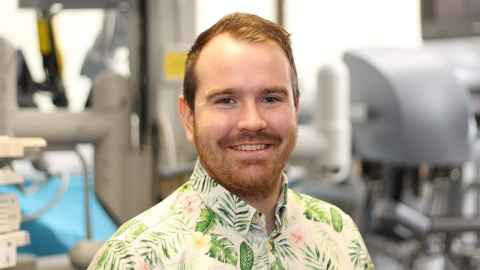Needle-free anaesthetic for skin graft surgery
30 November 2021
Dr James McKeage, Research Fellow at the Auckland Bioengineering Institute (ABI), is exploring how needle-free jet injection could be used for local anaesthetic before skin graft surgery and he has recently received SfTI (Science for Technological Innovation) Seed Project funding to do so.

For over a century hypodermic needles have provided a simple, direct method for delivering active molecules into the body, but needles have many drawbacks, particularly among people who have a genuine fear or phobia around needles.
Researchers at in the Bioinstrumentation Lab at the Auckland Bioengineering Institute (ABI) have been developing and investigating jet-injection as a promising alternative to hypodermic needles for several years. This technology delivers the drug as a hair-thin jet of fluid, at a speed that pierces the skin and delivers the drug without the need for needles.
They developed the world’s first jet injectors that are actuated by highly controllable electric motor, which is distinct from spring-loaded jet projection technologies currently available, and which allows drug delivery with unprecedented control and precision. They are working toward improving many aspects of their jet injector, and its potential for insulin delivery in diabetics, for dental local anaesthetic and for nicotine delivery to help people quit smoking.
While depth and volume of a jet injected drug can be controlled using an electric motor, says Dr McKeage, there is currently no method to control the spread of the injected fluid; it requires one ‘shot’ at a time.
He aims to improve this by developing a needle-free “multi-orifice nozzle”, would act less like a small gun and more like a mini shower rose, delivering a drug to multiple sites in one ‘shot’. This would allow for a greater volume of a drug to be delivered, and for more controlled spread than the technology currently allows. He is researching this particularly in relation to its use in general anaesthetic prior to skin graft surgery.
The current process of delivering anaesthesia for local skin
graft involves poking a number of needles over an area at very shallow angles, which is both time consuming for the clinician and requires multiple needle sticks. We’re exploring the potential of a jet injection with a nozzle
that is like a small shower-head.
“The current process of delivering anaesthesia for local skin graft involves poking a number of needles over an area at very shallow angles, which is both time consuming for the clinician and requires multiple needle sticks,” says Dr McKeage. “We’re exploring the potential of a jet injection with a nozzle that is like a small shower-head, that could deliver number of small jets of fluid at once, rather than multiple injections involving many needles.”
Increasing the volume deliverable into the subcutaneous tissue could also accommodate drugs that would otherwise require intravenous (IV) delivery due to the large dose required. “This is the case for the rapidly growing field of biologic drugs, where the need for hospital-based IV delivery that can take several hours and is predicted to constitute around 50% of the total treatment cost,” he says.
As far as he’s aware, he is the first to explore the potential of a ‘multi-orifice’ device for jet injection.
“If we can develop a device that increases the volume of a drug that is being delivered and allow for wide-spread delivery, this has the potential to improve the efficiency of New Zealand’s healthcare system, as well as considerably reduce anxiety and discomfort among patients.”
Margo White I Media adviser
DDI 09 923 5504
Mob 021 926 408
Email margo.white@auckland.ac.nz